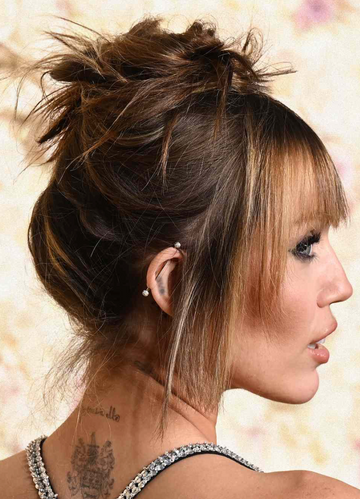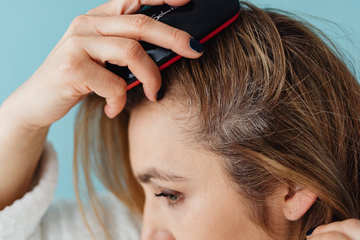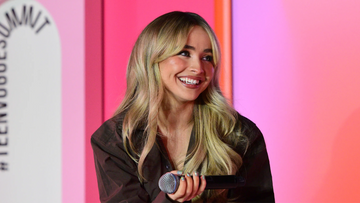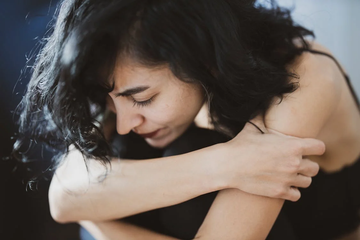Stop playing with fire (literally)
Remember when our flat irons had one heat setting—and it was scorching? No dial, no digital display, no logic. Just plug it in, wait for it to sizzle, and go to town. We’d straighten freshly washed, still-wet hair (don’t lie), ignore the steam cloud of doom, and wonder why our ends felt like hay. Simpler times? Maybe. Healthier hair? Absolutely not.
Fast forward to now, and we’re in our hair care + self care era. We’re reading labels, using heat protectant like it’s holy water, and (finally) asking the right questions—like what temperature should I flat iron my hair without damage?
The answer depends on your hair type, texture, and how much TLC your strands need. Too hot? You’re literally burning your cuticle. Too cool? You’ll be chasing the same section all morning. But with the right temp and the right prep, your flat iron can be your bestie, not your frenemy.
Let’s talk settings, styling secrets, and how to get that salon-level sleekness without the crispy aftermath.
What’s the best temperature to flat iron your hair?
If you've ever cranked your flat iron to 450°F thinking it’ll “just work faster,” you’re not alone—but your ends might still be recovering. The truth? The best temperature for straightening hair isn’t one-size-fits-all. It’s totally dependent on your hair’s natural texture, thickness, condition, and even its color history.
Here’s a general guide to keep those strands intact, thriving, AND surviving.
Fine or chemically-treated hair
Safe zone: 250–300°F
Your strands are fragile, so treat them like silk. Stick to lower heat, always use a heat protectant, and avoid repeated passes. (If your flat iron’s plates aren’t smooth or even, this is your cue to upgrade.)
This includes bleached, color-treated, or fragile strands that tend to snap when you so much as look at them. Keep it low and gentle—you’re styling, not sizzling.
Normal or medium-textured hair
Safe zone: 300–375°F
This covers most hair types that aren’t too coarse or too fine. If your hair isn’t damaged and holds a style fairly well, this mid-range is your sweet spot.
However, you do have some flexibility here. Start on the lower end and bump up slowly if needed—but only until your strands respond. And yes, second-day touch-ups should use even less heat.
Thick, coarse, or curly hair
Safe zone: 375–420°F
If your strands are strong, dense, or need serious smoothing, you might need to turn up the heat. Just do it mindfully—and always with a heat protectant.
You need power, but not punishment. Higher heat can help stretch curls or coils, but it’s still all about control. Use a brush or comb-chase method to reduce direct contact time, and always deep-condition weekly to replenish what heat takes out.
Damaged or super porous hair?
Keep it as low as possible. And honestly, maybe give the flat iron a break and lean into styles that love your natural texture while it recovers.
Still unsure?
Start low!
You can always go up, but once the damage is done, you’re looking at trims, masks, and lots of “should’ve known better” energy.
TYME tip: The TYME Iron Pro offers precision heat control from 300°F to 400°F, meaning you’re never overheating or under-styling. Plus, its patented shape lets you curl, wave, and straighten—all without switching tools. Efficiency and protection? That’s a win-win.
Want a visual temp guide for different styles (waves vs. straight vs. flipped ends)? That’s coming up next. Let’s make your flat iron work smarter, NOT hotter.
What are you trying to do—sleek, wave, or flip?
Once you’ve figured out your hair type, the next question is: what’re you going for? Because not every look requires cranking the heat. (Spoiler: sleek doesn’t have to mean scorched.)
Here’s how to match your styling goal to the ideal heat setting.
Pin-straight, silky-smooth strands
Temp range: 325–375°F
You’re going for that glass-hair finish? Go for even, consistent passes—not camping out on one section. The goal is to smooth the cuticle, not flatten your soul.
Soft waves or beachy bends
Temp range: 300–350°F
Yep, your flat iron can double as a wave wand. Use a slight twist of the wrist as you glide down each section. Lower temps = looser, more effortless-looking texture.
Flipped ends or volume boost
Temp range: 275–325°F
Want a little bounce at the ends or some oomph at the roots? Keep it on the cooler side—you're lifting, not reshaping the strand entirely.
Refreshing second-day hair
Temp range: 250–300°F
Already styled your hair yesterday? Drop the heat. A light touch-up goes a long way without layering on damage.
Your hair is a recipe—and each style has its own temperature “ingredients” to get the result you want. Too hot, and you’ll overcook it. Too cool, and it won’t hold. But just right? PERFect.
Not all heat settings are created equal (and your flat iron might be lying)
Okay, you’ve got your temp dial set to 350°F. Seems reasonable, right? But here’s the thing. Most flat irons don’t actually heat evenly across the plates. Some spike hotter in the middle, some barely reach the number on the screen. And if you’re using an older tool? Yeah… that “375°F” might be a total guess.
Before you even think about gliding that iron through your strands, here’s how to make sure your tool isn’t playing games.
– Check your plate material.
Ceramic plates offer that nice, even heat we love for preventing hot spots and snagging. Tourmaline takes it a step further with ultra-smooth glide and frizz-fighting negative ions. Titanium? Fast and furious—great for thick, coarse hair but not always gentle on finer textures.
– Do the tissue test.
A super simple way to test heat distribution: close your flat iron on a thin white tissue and hold for a few seconds. If it scorches, smokes, or browns immediately? Too hot. If it warms gently without discoloration? You’re good to go.
– Choose digital over dials.
Analog dials and twisty wheels are notoriously inconsistent. TYME’s flat irons offer precise, customizable digital heat settings—so you’re not guessing, you’re styling smarter.
– Upgrade if needed.
That flat iron you’ve had since high school? She’s tired. It might be time for a modern refresh. TYME’s signature irons not only offer temperature control you can trust, but their mineral-infused ceramic plates seal in moisture, smooth frizz, and protect your strands with every pass. Basically, it’s like skincare—but for your hair.
Because when your tool isn’t working with your hair, it’s working against it. And nobody has time for split ends, dullness, or surprise heat damage.
Consistent heat = consistent style. But more importantly? It’s your first defense against long-term damage.
Your flat iron temperature cheat sheet by hair type
No more guessing, no more fried ends. Just smooth, healthy results—tailored to your strands. Here’s your go-to heat guide.
– Fine, damaged, or color-treated hair
💡 250°F–300°F
You don’t need to crank the heat to get sleek results. Stick to the lower end to avoid breakage or fading. And yes, always use a heat protectant—even on low settings.
– Medium or wavy hair
💡 300°F–375°F
This is your sweet spot. Start in the low 300s and increase slightly if needed. Smooths out frizz without frying your ends.
– Thick, coarse, or curly hair
💡 375°F–410°F
You’ll need a bit more heat to get that sleek finish, but no need to max out the dial. The TYME Iron Pro delivers consistent, even heat that straightens faster, meaning fewer passes = less damage.
Protect your hair before you even plug in
Flat ironing can be a glow-up or a glow-down depending on how you prep. The difference between "wow, sleek" and "why is my hair snapping off?" comes down to how well you protect your strands before heat ever hits them.
First things first: never flat iron dirty hair. Product buildup, oils, and dry shampoo can literally cook your strands. Always start on freshly cleansed, fully dry hair (yep, even if your flat iron says “wet-to-dry”—we don’t trust it).
Next up: heat protectant is non-negotiable. Think of it like SPF for your hair—it creates a barrier between your strands and your flat iron, locking in moisture and minimizing damage. The TYME Thermal Protectant Spray is a favorite for a reason: it’s lightweight, smells amazing, and doesn’t leave behind greasy residue or crunchy ends.
Want next-level smoothness? Layer your protectant. Start with a lightweight leave-in conditioner or serum while your hair is damp. Then spritz on your heat protectant once it’s dry and detangled. The result: glossy, healthy hair that can handle the heat.
A few extra rules to bear in mind…
1. Section your hair while styling. Smaller pieces = less passes = less damage.
2. Keep the iron moving. Pausing in one spot is a surefire way to create a burn line (aka a tragic crease).
3. Don’t skip trims. Split ends don’t magically disappear—if anything, heat makes them worse.
And remember, the TYME Iron Pro is built with tech that evenly distributes heat, so you get that smooth finish without hot spots or unnecessary damage.
Prep smart, style safer, and your strands will thank you.
TL;DR: It’s not just about heat—it’s about the right heat
So, what temperature should I flat iron my hair? The answer isn’t one-size-fits-all. It depends on your hair’s texture, thickness, condition, and what kind of look you’re going for. But one thing’s for sure: blasting your strands at max heat “just because” is not the move.
The good news? With the right prep, tools, and technique, you can get sleek, shiny hair without sacrificing your strands in the process. Start low, go slow, and listen to what your hair is telling you. (If it smells weird or feels crispy, that’s a red flag, babe.)
And if your current flat iron isn’t cutting it? The TYME Iron Pro is here to level up your styling routine. It’s designed for smart, even heat, and it’s way more than just a flat iron. Think curl, wave, flip, and straighten all in one go. Your hair, your way.
It’s time to ditch the guesswork and the heat damage—and start styling with intention. Healthy, hot, and under control? That’s our vibe.





